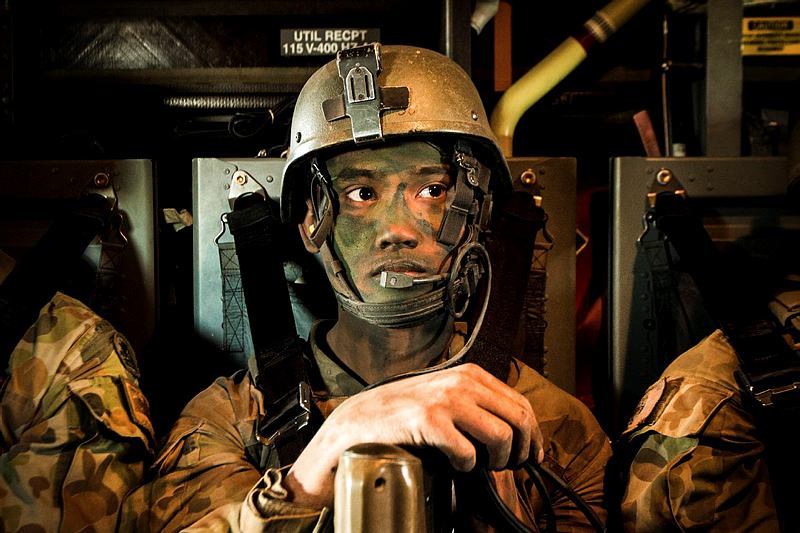
The ADF currently lacks the tradition, culture and organisational expertise to maintain and deploy a world class amphibious warfare capability. The current command and control (C2) structures don’t adequately address the high degree of specialisation needed to meet the likely demands of Australia’s emerging amphibious warfare capability.
One of the main reasons that countries with a genuine amphibious warfare capability have developed specialised C2 units is because of the inherent complexities in the planning and execution of ship-to-objective manoeuvre operations. In most cases, militaries have found that it’s desirable to have a standing C2 organisation for the amphibious taskforce as well as a standing landing force C2 element.
While the ADF has a designated Commander Amphibious Task Force (CATF) and staff, the Army currently plans to rely on the commander of 2nd Battalion, Royal Australian Regiment (2RAR) and his staff to both raise, train and sustain key elements of the ground combat element (GCE) and to serve as Commander of the Landing Force (CLF). The commander and staff of 2RAR are likely (if they are not already) to experience task overload, especially in the more complex missions that involve an amphibious ready group.
In addition currently the CATF is an O6 (Navy Captain), and the commander of 2RAR is an O5 (Army Lieutenant Colonel). Amphibious Warfare is complex and as such requires a permanent headquarters element that has the command authority over the elements assigned to support amphibious operations. In order to create clear and structured C2 the Chief of Defence and the service chiefs should establish a permanent land component headquarter element for amphibious warfare that is under the control of the Joint Staffed Amphibious Task Group (ATG).
The headquarter elements will be required to coordinate multi-service force-generation cycles, lead strategic shaping (engagement) operations, and be prepared for both crisis response and major contingency operations. The ATG and its component CLF and CATF command elements will be force employers, and the services should take on their proper roles as amphibious force generators, tasked with raising, training and sustaining the elements that will be assigned to the ATG.
In order to achieve these measures this new joint structure would establish a permanent command and control architecture with a joint staff-enabled Commander of the ATG with permanent component staffs. This will provide valuable continuity and the expertise needed to manage complex amphibious operations.
C2 however is but one key area that the ADF needs to evolve to ensure a world-class amphibious warfare capability. Some impressive work has been done over recent years to facilitate institutional and cultural change including; the embedding of US Marine Corps and Royal Marines officers into the ADF, lateral transfers from the Royal Marines and Royal Navy, and spending millions of dollars on sending ADF personnel to study US amphibious warfare. But there is a still a long way to go to equip the force with the necessary skills and culture for this capability to thrive.
In order to evolve the capability, the ADF must now move beyond temporary structures and foreign training. It should establish the means to imbed amphibious knowledge and skills across the force by bringing together expertise to enable the development and sustainment of the capability.
We firmly believe that the ADF needs to invest in the development of a joint Amphibious Centre of Excellence (ACE), which would provide a core of amphibious experts from across the services to deliver training and education courses in both the single service and joint environments.
It could deliver programs in individual training in areas from landing/assault craft and beach recovery to amphibious planning, ship to objective manoeuvre operations, logistics, joint fires and airspace management. It would also develop and deliver courses for the various units and headquarters across the Army, Navy and Air Force. Ultimately the ACE would become the hub for the intellectual and cultural development of an amphibious warfare capability.
The creation of an ACE will embed expertise within the ADF, draw together the various threads of amphibious knowledge and expertise, and bring training and education together in a joint environment, firmly based on Australian doctrine and tactics, techniques and procedures—as opposed to those from overseas military forces. Furthermore, the ACE would enhance opportunities for amphibious specialists from all three services for postings and career advancement.
The ACE should also aim to be a regional as well as national centre of excellence. It could play an important role in building partner capacity through participation in the Defence Cooperation Program and having overseas military students on select courses and programs.
By cementing C2 structures and developing the ACE, Australia would be able to grow the culture and organisational expertise necessary for a world class amphibious capability.

